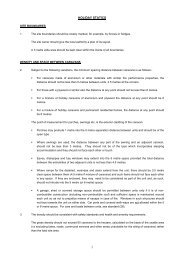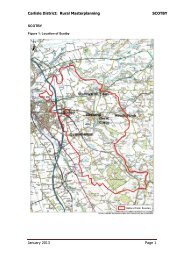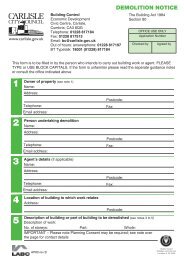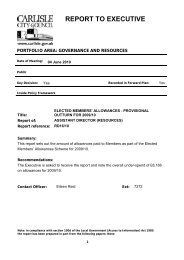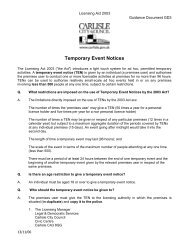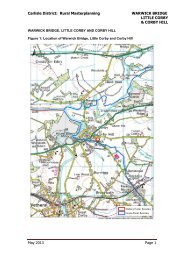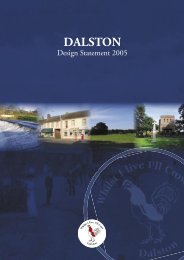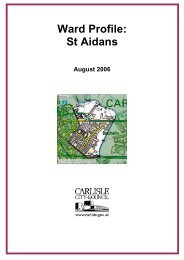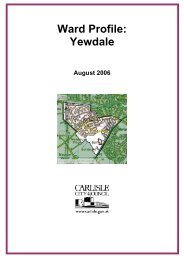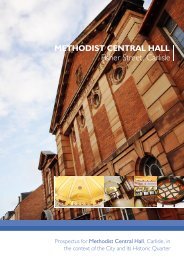Carlisle District Local Plan.indd - Carlisle City Council
Carlisle District Local Plan.indd - Carlisle City Council
Carlisle District Local Plan.indd - Carlisle City Council
Create successful ePaper yourself
Turn your PDF publications into a flip-book with our unique Google optimized e-Paper software.
<strong>Carlisle</strong> <strong>District</strong> <strong>Local</strong> <strong>Plan</strong> 2001 - 2016 Revised Redeposit draftPOLICY H8 Conversion of Existing PremisesProposals for the conversion of non-residential property to provide residentialaccommodation in locations where planning permission for new build residentialdevelopment would not be granted will not be approved unless:1. the building is of sufficient historic or architectural interest or which makes acontribution to local character to warrant retention and alternative use is notviable; and2. an appreciation of the historic, architectural, or archaeological significanceof the building is submitted with the application against which the proposeddevelopment can be assessed, together with the need for further archaeologicalrecording3. the building can be converted without extensions or major alterations which woulddestroy its character; and4. the details of the proposed conversion respect the building’s character; and5. adequate access and appropriate car parking can be achieved whilst respectingthe character of the landscape6. the design and appearance of the building should be in keeping with itssurroundings.Where appropriate, in order to retain the character and fabric of historic farmbuildings, development rights originally permitted by Classes A to E inclusive of PartOne of Schedule Two to the Town and Country <strong>Plan</strong>ning General Development Order1995 as amended may be withdrawn by a condition attached to a planning consent.The conversion of very remote rural buildings will be subject to sustainability tests toassess their acceptability.5.46 Policy H7 states clearly that outside established communities, permission will not be givenfor new dwellings in the countryside unless supported by an agricultural or forestry need.This approach is in line with national guidelines and Structure <strong>Plan</strong> policies. Nevertheless,there are some non-residential buildings which remain attractive features in the countrysideand whose design and appearance are in keeping with their surroundings. In consideringalternative uses the <strong>City</strong> <strong>Council</strong> will pay due regard to Government advice in paragraphs17and 18 of PPS7 Sustainable Development in Rural Areas, where the emphasis is placedon re-use for economic development purposes. In many instances the conversion andre-use of historic farm buildings for these uses causes less damage to the fabric of thebuildings than conversions to residential uses. In certain circumstances, however, the <strong>City</strong><strong>Council</strong> will be prepared to allow such buildings to be converted to residential use whereproximity to other dwellings may make residential use the most appropriate option.5.47 The criteria set out in the policy will enable the <strong>City</strong> <strong>Council</strong> to distinguish betweenproposals where appropriate buildings can be converted and inappropriate proposals whichwould simply result in the creation of additional isolated dwellings in the countryside. Whichmay cause harm to the landscape through the creation of gardens and access tracks whichdetract from rural character and local distinctiveness. In cases, where it is uncertain whethermajor repairs or rebuilding is required to make the building habitable, it will be necessaryfor applications to be accompanied by a structural engineer’s report on a building todemonstrate that it is in a sound state and that major repairs are not necessary.82 September 2006



